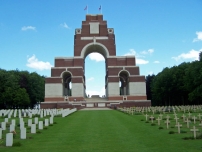| First Name: | Reuben Henry | Last Name: | MIALL | |
|---|---|---|---|---|
| Date of Death: | 15/09/1916 | Lived/Born In: | Dalston | |
| Rank: | Private | Unit: | Coldstream Guards1 | |
| Memorial Site: | Thiepval Memorial, France | |||
Current Information:Age-22 46, Shrubland Road, Dalston
The Battle of the Somme (July-November, 1916) By the beginning of September, 1916, the Battle of the Somme had been raging for two months. Thousands of men had already been killed or wounded or were simply missing, never to be seen again and and just a few square miles of the French countryside, all in the southern part of the battlefield, had been captured from the enemy. Mistakes had been made by the various commanders and would be continued to be made but there was no turning back as the British, Australians, South Africans, New Zealanders and Canadians carried on battering away at the German defences in the hope of a breakthrough, So it continued all the way through to November with nearly every battalion and division then in France being drawn into it at some stage. In the end the German trenches had been pushed back a few more miles along most of the line but the cost in lives had been staggering. By the end of the fighting in November, 1916, British Army casualties numbered over 400,000, killed, wounded and missing. On 15th September, 1916, the offensive on the Somme was renewed with a full scale attack on the German 3rd line of defences. Four Army Corps were used on a front that stretched from Combles, through the village of Flers and on to Courcelette.. The artillery barrage that preceded this attack was more concentrated than that on 1st July and the attack itself was more successful. The villages of Flers, Martinpuich and Courcelette were captured and the enemy was finally pushed out of High Wood, but the breakthrough was not achieved and the reality was that when the battle ended on 22nd September, the front line had just been moved forward a mile or so. The battle is notable for being the first time that tanks were used. The Guards Division were heavily involved in the attack on 15th September when 2nd Guards Brigade on the right and 1st Guards Brigade on the left attacked the village of Lesboeufs from a position in front of Ginchy. 2nd Guards Brigade had 3rd Grenadier Guards and 1st Coldstream Guards in front with 1st Scots Guards and 2nd Irish Guards in the second line. They formed up south-east of the Ginchy-Lesbouefs road in a mass of shell craters so as to be clear of the ruins of Ginchy which was a prime target for the German gunners. Here they were very cramped with only ten yard gaps between each of the nine waves that went over the top. At 6.20am, zero hour, they followed the creeping artillery barrage some thirty yards to the rear of it but when they topped the first rise, 3rd Grenadier Guards and 1st Coldstream Guards met heavy fire from Straight Trench and the Quadrilateral, an enemy strongpoint. Nevertheless they pressed on though drifting somewhat to the left, dealing with any of the enemy occupying advanced positions in shell holes as they did so. The advance of 2nd Guards Brigade continued with all four battalions mixed together and they forced their way into the northern part of the Triangle, another heavily fortified Germen redoubt, and part of Serpentine Trench where the wire had been largely blown away by the British artillery, making their task somewhat easier. By 7.15am, 2nd Guards Brigade had reached their first objective but the heavy fighting had greatly reduced their numbers and here the attack came to a halt. They formed a defensive flank on the right and although some one hundred men did manage to advance a further half mile it was not until 25th September that they finally managed to capture Lesboeufs. One of the many casualties suffered by the 1st Coldstream Guards battalion on 15th September was Reuben Miall. |
||||
| « Back to Search Results | ||||
| If you think any of the information shown here is incorrect, Click Here to submit your amends and comments | ||||




